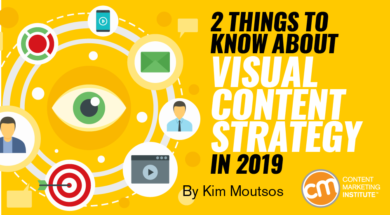
It’s time for content marketers and content strategists to take back control of their visual content strategy.
That’s the message Buddy Scalera delivered in a Content Marketing World talk earlier this year. It’s a topic close to his heart. By day, Buddy works as a mild-mannered content strategist in the pharmaceutical industry. By night, he’s an avowed comics geek who consults for Marvel Comics and teaches and writes about visual content strategy.
But don’t worry. He’s not suggesting you upset your relationship with your creative services or visual design teams. He’s suggesting you wrest control of your visuals from Microsoft, Google, Facebook, Twitter, and LinkedIn.
Content marketers should wrest control of their visuals from Microsoft, Google, Facebook, etc. @BuddyScalera
Click To Tweet
At Content Marketing World, we asked Buddy why it’s important for content marketers and content strategists to review their visual content strategy today. You’ll find the highlights of our conversation in the video, which is part of our Mastering Content Marketing video series.
After you watch, read on for a deeper dive into the issues he raises.
Don’t let browsers control your visual content
Brands often start creating visual content without actually having a plan for how they’re going to scale it across all their different platforms. They start usually with their own platform or their social media platform, but then they don’t think past that … You need a strategy that will ensure that that one piece of content scales gracefully across all of your platforms.
In his presentation, Buddy explained a timely reason to focus on how images scale: Google’s mobile-first indexing.
If you’re not taking control of how Internet Explorer, Chrome, Firefox, or other browsers render your images on mobile sites, you may be inadvertently telling Google the images on your site aren’t designed for mobile first.
Google may not like it if you ignore how your site’s visuals render on #mobile, says @BuddyScalera.
Click To Tweet
That graph or table looks great on your desktop, for example, but it’s nearly impossible to read on a phone with a display of only 320 pixels.
You can find out how an image looks on mobile without leaving your desktop. Grab the corner of your browser window and drag it toward the middle. As the window gets smaller, you can see the breakpoints where the copy reflows and images resize.
What do you do about it? In some cases, the answer is to include multiple images designed for different device widths and designate, through simple code, which one to use for different display sizes. The article in the box below goes into detail on how to do that.
Google may not like it if you ignore how your site’s visuals render on #mobile, says @BuddyScalera.
Don’t let social media platforms make image choices for you
Every once in a while, test your content – new and old – on the social platforms that you’re hoping people will use to share it. How does that content look on LinkedIn? How does it look on Facebook? Is it grabbing the image that you want it to grab?
You may find social media tools choose the wrong image or crop it in a way that robs it of its resonance. An automated tool can’t be as careful with your images as you and your art director will be.
By using Open Graph tags, you can dictate which image gets shared. You may need to work with your tech team to integrate it onto your site, but the little piece of code gives you control of your visuals.
Use Open Graph tags to dictate and automate which images get shared from your site, says @BuddyScalera.
Click To Tweet
Using Open Graph tags for new articles may be perfectly doable, but what about your existing content? Do you have to check every article on your site? That’s up to you (and your strategy), but it makes sense to check articles that have performed well and those that aren’t being shared as much as you expected.
Bonus tip: Be a content maker, not just a content marketer
Content marketing has evolved over the last couple of years. Some of the things we said last year might not be true anymore and some of the things we say right now might evolve in six months. It’s really important for you to be a doer and a maker in your own world so you understand those changes. That’s what your team is depending on you to do.
In fact, Buddy told the Content Marketing World audience that creating content must be a requirement for anyone in the content marketing industry. If you’re not creating, you don’t understand what it takes to create.
Creating #content must be a requirement for anyone in the #contentmarketing industry, says @BuddyScalera.
Click To Tweet
And don’t shy away from the technical side.
“Be the person who understands content because you create content, you make content, you understand it, you optimize it,” Buddy says. “Yes, you even learn some code because that’s part of your job. That’s one of the tools in your toolbox.”
What tools or skills are helping you take back control of your visual content strategy? Let us know in the comments.
HANDPICKED RELATED CONTENT:
Catch up on previous episodes of the Mastering Content Marketing video series. And get the lowest rates to Content Marketing World 2019 if you register by December 31, 2018.
Cover image by Joseph Kalinowski/Content Marketing Institute
The post 2 Things to Know About Visual Content Strategy in 2019 appeared first on Content Marketing Institute.
from Content Marketing Institute https://ift.tt/2Bik2ye



No comments:
Post a Comment